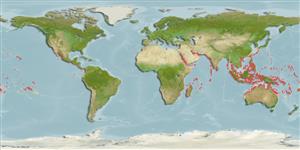>
Blenniiformes (Blennies) >
Blenniidae (Combtooth blennies) > Salariinae
Etymology: Parablennius: Greek, para = the side of + Greek, blennios = mucus (Ref. 45335).
More on authors: Jordan & Seale.
Environment: milieu / climate zone / depth range / distribution range
Écologie
marin démersal; profondeur 1 - 10 m (Ref. 58302). Tropical
Indo-West Pacific: Persian Gulf, central coast of Oman, Pakistan, southwest India, Sri Lanka, Gulf of Thailand, and Philippines (Ref. 11441). Intoduced to Hawaii (Ref. 58302).
Taille / Poids / Âge
Maturity: Lm ? range ? - ? cm
Max length : 6.2 cm TL mâle / non sexé; (Ref. 11441); 5.0 cm TL (female)
Description synthétique
Clés d'identification | Morphologie | Morphométrie
Épines dorsales (Total) : 12; Rayons mous dorsaux (Total) : 14 - 15; Épines anales: 2; Rayons mous anaux: 16 - 17.
Facultative air-breathing in the genus (Ref. 126274); Adults are found solitary or in small groups in sheltered turbid coastal reefs (Ref. 90102). Benthic in algae and fouling communities in estuaries (Ref. 58302). Oviparous. Eggs are demersal and adhesive (Ref. 205), and are attached to the substrate via a filamentous, adhesive pad or pedestal (Ref. 94114). Larvae are planktonic, often found in shallow, coastal waters (Ref. 94114).
Life cycle and mating behavior
Maturities | Reproduction | Spawnings | Egg(s) | Fecundities | Larves
Oviparous, distinct pairing (Ref. 205).
Randall, J.E., 1995. Coastal fishes of Oman. University of Hawaii Press, Honolulu, Hawaii. 439 p. (Ref. 11441)
Statut dans la liste rouge de l'IUCN (Ref. 130435)
Menace pour l'homme
Harmless
Utilisations par l'homme
Outils
Articles particuliers
Télécharger en XML
Sources Internet
Estimates based on models
Preferred temperature (Ref.
123201): 25.2 - 29.3, mean 28.4 °C (based on 3649 cells).
Phylogenetic diversity index (Ref.
82804): PD
50 = 0.5000 [Uniqueness, from 0.5 = low to 2.0 = high].
Bayesian length-weight: a=0.01072 (0.00457 - 0.02514), b=3.01 (2.83 - 3.19), in cm total length, based on LWR estimates for this Genus-body shape (Ref.
93245).
Niveau trophique (Ref.
69278): 2.9 ±0.1 se; based on size and trophs of closest relatives
Résilience (Ref.
120179): Haut, temps minimum de doublement de population inférieur à 15 mois (Preliminary K or Fecundity.).
Fishing Vulnerability (Ref.
59153): Low vulnerability (10 of 100).
